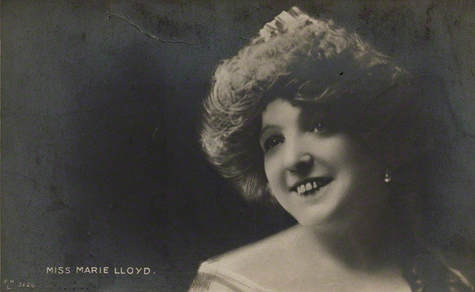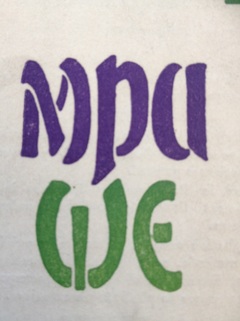|
My Time Traveller piece broadcast on BBC Radio 3's Essential Classics on Thursday 8th February 2018, was entitled 'Suffragettes on the Run' - and you can listen to it here (it's 1hr and 12 minutes into the programme) Music Hall star and Actresses' Franchise League member Marie Lloyd, no stranger to campaigning for the rights of performers within the theatrical profession, lent her support to suffrage societies by singing at the WFL’s Old World Fair at Caxton Hall in 1909 as part of a series of concerts to raise funds, and appearing in How The Vote Was Won in the same year, presumably as the character of Maudie Spark, the music hall comedienne. As an influential, wealthy and famous performer, she was able to support the sisterhood of suffragists in unique ways. One such gesture involved her allowing her theatrical hamper to be used to smuggle a militant speaker into a meeting at the London Pavilion in 1913. Marked ‘Marie Lloyd, Pavilion. Luggage in advance,’ the hamper contained the WSPU speaker Annie Kenney, who was out of prison on licence after a period of hunger-striking and subject to immediate re-arrest under the ‘Cat and Mouse’ Act if she appeared in public. Kenney wrote about the incident in her autobiography, Memories of a Militant, recalling the workmen who unknowingly delivered her to the theatre in the hamper making ‘growls…about the weight, about actresses having no consideration for the poor men who had to carry their baggage, and so on. I was turned, toppled, banged, dropped, before one of them got me (in my hamper, of course) on to his back.’ The ruse worked, and despite the police officers stationed around the entrances to the theatre, Kenney made it inside unnoticed. The London Pavilion was a regular site for WSPU meetings in 1913, and the building that housed the theatre is still a prominent part of Piccadilly Circus. I remember it housing waxworks music show 'Rock Circus' when I was a child and it most recently was the site of Ripley's Believe it or Not. Built in 1885, it functioned as a music hall and variety venue until 1912, when it became the home of a string of musicals. as well as mixed bills. You can see a London Pavilion programme from 1913 here - and on the bill is a performance by Graham Moffat's company of Scottish Players. Moffat was a suffragist and the author of suffrage play 'The Maid and the Magistrate', published by the AFL. His wife, actress Maggie Moffat, was the second Scottish suffragist to be imprisoned for campaigning, when she was arrested in 1907. The Glasgow WSPU delegate for the Women's Parliament in Caxton Hall, Maggie Moffat was one of fifty-three women arrested when mounted police broke up a group of women marching peacefully to the House of Commons with a resolution for the Prime Minister. She was subsequently imprisoned in the second division in Holloway.
But back to the story in question!
1 Comment
I wrote a blog post about suffrage plays for the Vote 100 project - you can read it here. Whilst doing it, I began to compile a list of all the professional performances of suffrage plays, old and new, since 2008... and I'd like you to check yours or one you attended or one that you are putting on next year is on the list, and if not, comment on this post so I can add it to the list!
I am including:
At the moment I am not including projects or performances that have only taken place in formal education institutions, so schools, colleges and universities... unless those performances were/are open to the public or are made available to the public online through video, audio or other online dissemination. Please don't be cross if yours is not there - comment and I will add it to the list. This first list is purely made up of projects and performances I remember being in, putting on, attending or knowing about so is limited by those factors. Please comment and let's make it a much better and more inclusive and more extensive list! In groups of ten to fifteen at a time, audiences will set off on a specially prepared route through Covent Garden starting from the historic Theatre Royal Drury Lane. At intervals throughout the route, actors and actresses begin their performances as the groups draw near, engaging audience members in comic and moving moments from the struggle for Votes for Women with pieces both inspired by and directly from the plays and experiences of the Actresses’ Franchise League… Audiences will discover theatrical Suffragette secrets they never knew Theatre Land had been keeping! “Absolutely brilliant” 2. Male support for Votes for WomenIn the film 'Suffragette' the character of Hugh Ellyn, played by Finbar Lynch, is described by the policemen watching his property as being part of the 'Men's League.' Married to a known militant, he has apparently previously been imprisoned for his role in the suffrage campaign, and we see him in the film helping the WSPU to organise and carry out violent militant actions. Although we never get to hear any of his story, it's good to have acknowledgement of the male support for suffrage in the film - as it's an important part of the history of the campaign. It's not made clear in the film or production notes, but I reckon, given his militant leanings, Lynch's character is most likely to have been part of the Men's Political Union for Women's Enfranchisement (MPU). The MPU was directly affiliated with the WSPU, the society featured in the film 'Suffragette,' and shared their colours of purple, white and green. As well as their headquarters near Charing Cross Station in London, they had a number of regional branches across the UK, including in Eastbourne, Birmingham and Letchworth and at both Oxford and Cambridge Universities. One branch, in East Grinstead, was apparently "actually the outcome of an anti-suffrage meeting there... One gentleman was so struck with the feebleness of the arguments that he proceeded to found a branch of the Men's League."
Seen the Suffragette film and interested in finding out a bit more about the stories it tells? Well, hello! 1. Police Surveillance PhotosIn the Suffragette film, we see police taking and collating surveillance pictures of suspected militant women both out in public and whilst they are in prison. As violent direct action became more frequent, surveillance of militant women and their networks by police increased. The photographs could then be circulated not only to police forces up and down the country but also to potential sites of protest, like galleries, so that known militants could be refused access.
The women in the pictures below include Mary Richardson (no. 11) who slashed the Rokeby Venus in the National Gallery in 1914 in protest at the treatment of Emmeline Pankhurst in prison, and Kitty Marion (no. 13) a music hall performer and member of the Actresses' Franchise League. It's curious that Marion's publicity photograph has been used here - there are other pictures of her taken by press and police photographers that could have been used but perhaps this full face image was thought more valuable. So this month I graduated with a PhD in Drama from the University of Manchester after four years of research and study that has been a total joy. I can't believe how it much it has changed me.
I was just casually reading through Votes for Women from 23rd January 1914 when this leapt out at me and made me giggle:
The final hurrah of the Actresses' Franchise League was in December 1958 at a special Ball held in the Savoy Hotel.
The programme for the event is fantastic - a treasure trove of information and a tantalising glimpse into what sounds like an amazing evening. The great and the good had their dinner at 8pm but there was a later "Actresses' Supper" served at 11pm, presumably so that actresses in shows could come and join the festivities after their performances had come down.
This article was published in the Observer newspaper on 24th August 2014 - it was originally published by the same paper on 24th August 1986 and is about the vote of the Magic Circle, the International Brotherhood of Magicians, in that year on whether to allow female magicians to become members of the organisation.
Actress and Actresses' Franchise League member May Whitty's memories of August 4th 1914:
Aug 4 – “We played as usual for Church, traveled home, supped with Cissie L and an air man Carlton after going to Hippodrome, all so strange, unreal – wild rumours of naval engagements, ships sunk – the streets as we walked home were full of excited people waving flags – Singing Marseillaise, riding on tops of cabs – all so horrifying, then the tension – the rumours – the hopes the fear, and the Sheer World of such stupidity, and life went on..." |
NaomiThoughts, reflections, bits of research Archives
April 2023
Categories
All
|


 RSS Feed
RSS Feed